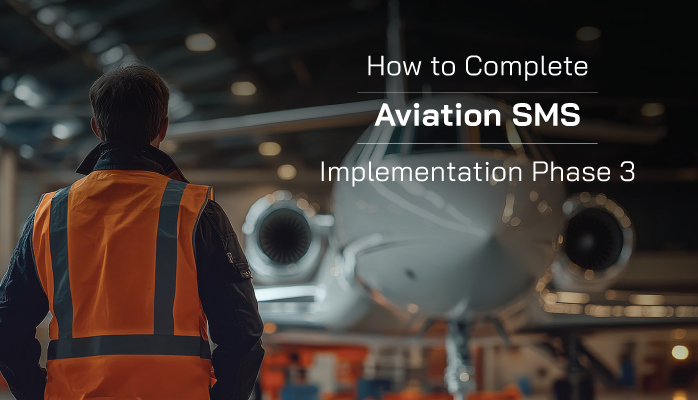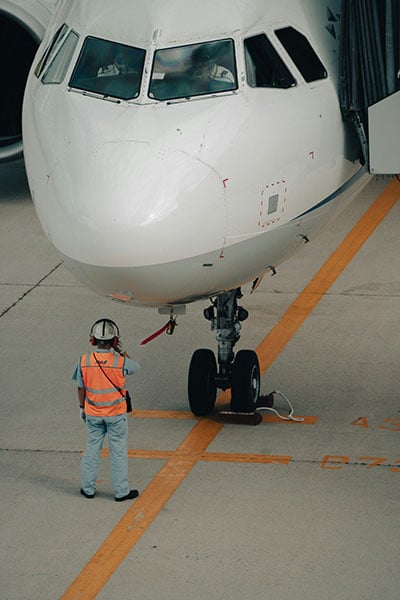What Is Phase 3 of Aviation SMS Implementation

Phase 3 of Aviation SMS implementation is largely about implementing your Safety Risk Management process. Your SRM process is where you document and design your safety management system. Designing your SMS is a two-step process:
- First you design and document your SMS; and
- Second, you update it as your SMS and/or environmental change.
Phase 3 of aviation SMS implementation is a major hurdle because it is extensive, including such things as:
- Describe each of your safety systems;
- Document resources for each system;
- Document, analyze, and assess each hazard;
- Performing hazard analysis;
- Documenting important processes;
- Define Acceptable Level of Safety;
- Provide resources with a confidential method of reporting issues;
- Provide means for sharing relevant safety data, such as Lessons Learned;
- Provide a hazard reporting (and other data acquisition) system; and
- Establish safety performance indicators (i.e., KPIs).
Implementing Phase 3 can take anywhere from 1-3 years, but can vary significantly depending on several factors:
- Size of organization;
- Complexity of organization; and
- Amount of inherent risk in operations.
Bigger size, more risk, and greater complexity will involve significantly more time to complete phase 3.
How to Identify, Describe, and Document Systems and Safety Resources
Systems are distinct parts and areas within your organization. Each system has:
- Its own set of procedures, tasks, etc.
- Its own set of requirements, roles, personnel; and
- Its own set of safety risk controls, identified hazards, and identified risks.
For example, Flight Ops and Ground Ops could be logical systems within your company. Defining these systems means recognizing them and documenting them. Your Systems should each be accounted for and documented in full, which includes the following:
- Analyze all safety aspects of a system, including its purpose, applicable location(s), and so on;
- Document all risk controls that are functioning in the system;
- List policies and procedures that affect system safety;
- Document other resources you will use to control risks, such as job checklists, software, machinery, and other technology you will use to mitigate risk;
- Goals and objectives related to the system; and
- Documenting high-level expectations for how the system will operate.
Describing systems in your aviation SMS, simply put, is documenting how each system attempts to mitigate safety.
Related Articles on Aviation Safety Risk Management
- Straight Talk About Aviation Safety Risk Management
- What Are Important Activities in Safety Risk Management (SRM)?
- 4 Elements of Safety Risk Management (SRM)
How to Define Acceptable Level of Safety
The aviation SMS, Acceptable Level of Safety (ALoS) is how you define the maximum level of risk you are willing to “inherit” or “take on” or “accept.” You will make decisions on ALoS based on your risk assessment for a given concern.
To define your ALoS, you need to:
- Define the criteria for each level of severity in your risk matrix; and
- Define the criteria for each level of likelihood in your risk matrix.
These criteria should be formally documented. Once you have defined these criteria, you can define what is and isn’t acceptable based on risk assessments. ALoS should be documented as well for managers who are assessing issues and making safety decisions to reference.
How to Document All Identified Hazards and Risks

As you identify hazards during issue management, you need to be documenting these hazards in a list. Hazards should:
- Be organized by the System they are relevant to;
- Be organized in a tree, with hazard categories and sub-categories (this is a good practice); and
- Be a dangerous condition, per the definition of a hazard.
It’s extremely important to make sure that a documented hazard is actually a hazard, and not a root cause or potential risk occurrence. Once you have identified your hazards, you should perform a risk analysis on each hazard to determine what problems that hazard can lead to:
- Identify each potential risk occurrence that the hazard can plausibly lead to if the hazard occurs;
- Document each potential risk concern;
- Analyze the potential risk occurrence for how severe it would be, how likely it is to occur, and how well it is controlled with existing risk controls;
- Document your analysis for a paper trail, which can be useful during safety audits or future reviews;
- Performing a risk assessment on each risk occurrence; and
- Documenting that risk assessment.
This creates a thorough paper trail for auditors to review, and for yourself to update should the hazard or risks change over time.
How to Provide Hazard Reporting System With Confidential Reporting
Developing a hazard reporting system involves:
- Providing multiple ways to report issues;
- Developing a formal process for reporting issues;
- Providing means of reporting issues confidentially;
- Providing hazard identification training;
- Distributing other guidance for reporting, such as mandatory/voluntary reporting guidance, non-punitive reporting policy, etc.; and
- Training employees on the hazard reporting system.
A hazard reporting system is an important part of Phase 3 of SMS implementation because safety reporting will be one of the foundations of your safety program, and you need to design a good reporting system to practice quality assurance.
Related Articles on Hazard Reporting in Aviation SMS
- How to Develop a Hazard Reporting System in Aviation SMS [With Free Checklist]
- What Is Offline Hazard Reporting in Aviation SMS
- Best Practices for Hazard Reporting in Aviation SMS - With Examples
How to Establish Key Performance Indicators
Before you choose key performance indicators (KPIs/SPIs), you need to understand what KPIs are. Review KPI resources first, and once you understand what KPIs are, you need to:
- Review goals and objectives;
- Review existing classifications and metrics; and
- Choose classifications and/or metrics that match your objectives.
KPIs can be classifications that you use during issue management, and they can be data metrics you use to monitor safety performance.
How to Establish Means of Sharing Safety Data
Establishing means of sharing safety data is, essentially, your way of planning how you will practice safety promotion. Here are some things to document and plan for:
- What means you will use, and when, to document important safety information relevant to employees;
- What kinds of practices will you do regularly, such as weekly safety debriefs, to promote safety;
- How often you will hold safety meetings, and who will be involved;
- Create newsletter templates that you will use to create newsletters;
- Create safety posters; and
- What will be covered in initial SMS training?
Last updated February 2025.








